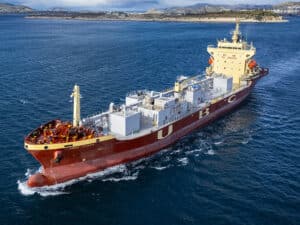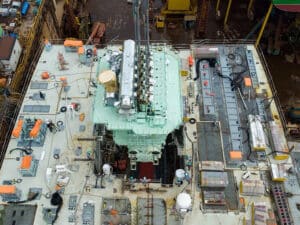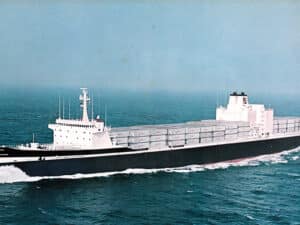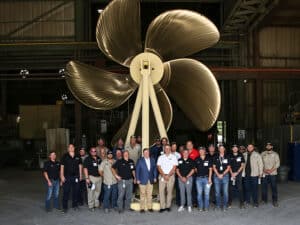
Landmark methanol-fueled containership named Laura Maersk
Written by Nick Blenkey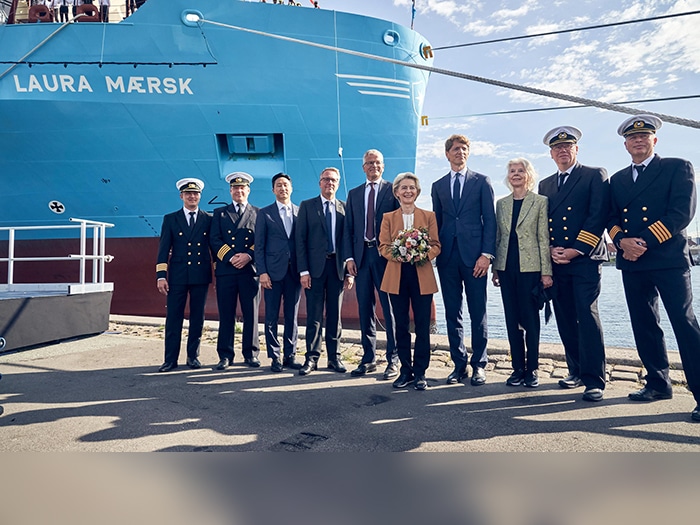
Laura Maersk was named by godmother EU Commission President Ursula von der Leyen (center) in a quayside ceremony in Copenhagen.
Well, now we know the name. Maersk has chosen a name steeped in company tradition for its first methanol-fueled containership: Laura Maersk. The name reveal came when the ship’s godmother, EU Commission President Ursula von der Leyen, christened the vessel by breaking a champagne bottle over its bow at a ceremony in Copenhagen. Other speakers at the ceremony were Maersk Chair Robert Uggla and Maersk CEO Vincent Clerc.
“Laura Maersk is a historic milestone for shipping across the globe. It shows the entrepreneurial spirit that has characterized Maersk since the founding of the company. However, more importantly this vessel is a very real proof point that when we as an industry unite through determined efforts and partnerships, a tangible and optimistic path toward a sustainable future emerges. This new green vessel is the breakthrough we needed, but we still have a long way to go before we make it all the way to zero,” Clerc said
Laura is a name deeply rooted in some Maersk’s very early innovative landmarks. When Captain Peter Maersk Moller bought his first steamship in 1886, he named it Laura. With its steam engine, Laura was a product of the second industrial revolution, making its impact on the shipping industry significant. Laura was also the first vessel bear the white seven-pointed star on a light blue background that later would become the logo of A.P. Moller – Maersk.
Maersk has an ambitious 2040 target of net zero greenhouse gas emissions and aims to transport a minimum of 25% of Ocean cargo using green fuels by 2030. The 2,100 TEU (twenty-foot-equivalent) feeder vessel Laura Maersk is an important step toward the long-term objective of gradually renewing the entire Maersk fleet to operate solely on green fuels. Maersk has 24 additional methanol vessels on order for delivery between 2024 and 2027 and a policy to only order new, owned vessels that come with a green fuel option.
INDUSTRY RETHINK ON FUEL OPTIONS
Maersk’s decision to opt for methanol, and in particular green methanol, has prompted an industry wide rethink on what its best options are for bridging fuels that will take it to true zero-carbon fuels such as ammonia. That debate us still ongoing, with methanol gaining steady momentum and the pipeline for supplies of green methanol starting to open up.
SHIP FACTS
Meantime, here are a few facts on the Laura Maersk.
Built at Hyundai Mipo Dockyard in Ulsan, South Korea. Shipbuilding contract and specifications made in June 2021, delivery 10 July 2023.
Flag and class: Danish flag, ABS class
Specifications:
- Length: 172 meters
Breadth (molded): 32.2 meters
Speed: 17.4 knots
The vessel is designed to sail in sea ice of up to 1 meter thickness in the Baltic Sea
Deadweight: 32,614 tonnes at Scantling Draft of 11.0 meters.
Lightweight: 10,598 tonnes which equal 5,300 Tesla Model Y autos - Fun fact: The vessel could load around 5,000 African elephants.
Container capacity
- 2,136 TEU (twenty-foot-equivalent), or 398 RFEU (Reefer forty-foot-equivalent)
- On deck: 1,310 TEU (13 Row / 7 Tier)
- On hold: 826 TEU (11 Row / 6 Tier)
Fun fact: If you line up 2,100 TEU containers, the line would be 13 kilometers long – corresponding to 124 football pitches, or nearly two times the length of the Oresund bridge connecting Denmark and Sweden.
Inside the vessel
- 28 cabins in total
- Living quarters, recreation room and action room
- Dining room, Duty mess, Galley, Provision stores
- Ships Control Center and Fire Station
- Fitness Room, Medical Treatment Room and Laundry Room
- 2 changing rooms
Engine
- Main engine: HYUNDAI – MAN B&W 6G50ME-C9.6-LGIM-HPSCR, 10,320 kW
- Auxiliary engines: 2x HiMSEN H32DF-LM, 3000 kW w/ 2820 kW Electrical Generator; 1x HiMSEN 6H21M, 1320 kW w/ 1240 kW Electrical Generator
- Methanol fuel capacity: 1400 m3 (2 tanks split longitudinally) located forward of the engine room bulkhead
- The vessel can sail up to 6,000 nautical miles on green methanol corresponding to 10,800 km (1 nautical mile = 1.8 km)
- The engine is a Dual Fuel type, meaning it can run on methanol as well as traditional marine fuels. The same applies to the auxiliary engines.
Fun fact: The auxiliary engines could supply electricity for 38,000 homes.
Green fact: Running on methanol the vessel saves up 100 tonnes of CO2/day compared to a sister vessel sailing on HFO
Fuels.
Methanol fact: Consumption of methanol is approximately double that of traditional fuel due to the lower energy density.
Operation
- The vessel will be in operation by beginning of October
- Trade lane: Bremerhaven- Kiel Canal- Helsingborg- Halmstad-Fredericia-Kalundborg- Kiel Canal – Bremerhaven
- Bunkering: the vessel will bunker in Rotterdam every five weeks until the bunkering terminal in Aabenraa is ready
- Fuel providers: OCI, Equinor and European Energy

